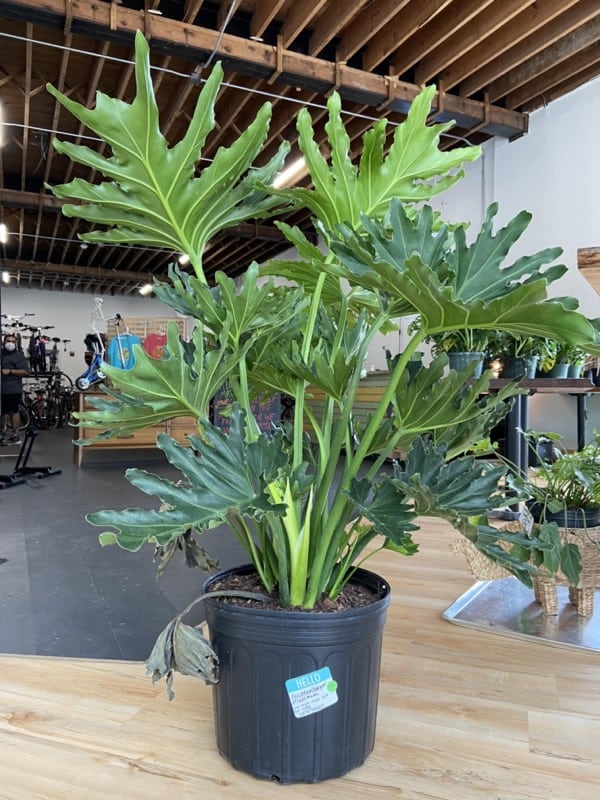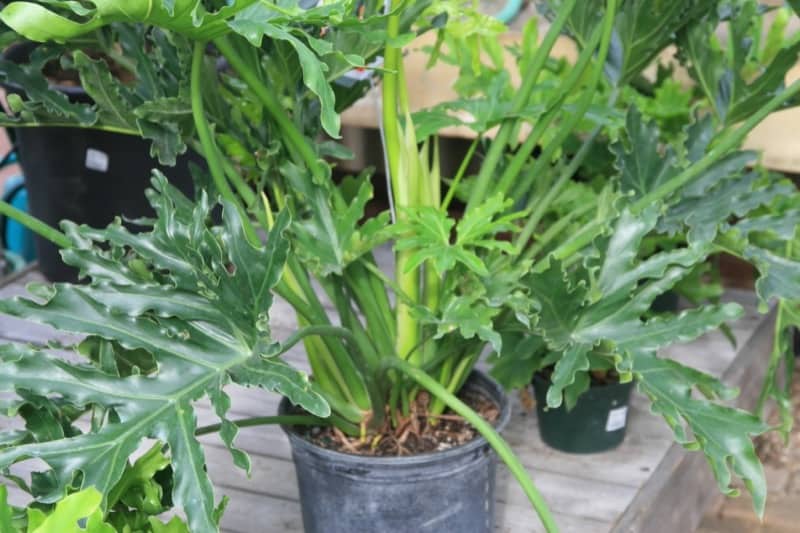The Philodendron Selloum Hope has showy, wide leaves to bring a tropical feel to your home or office.
This is a popular houseplant choice for many because they’re easy to care for.
Learn how to care for the Philodendron Hope Selloum in this guide.
Philodendron Hope Selloum Overview
A native of South America, this Philodendron bipinnatifidum, is a hardy plant featuring attractive lobed foliage. This particular philodendron, the “Hope Selloum” has recently been reclassified as the Thaumatophyllum bipinnatifidum, and similarily to the Philodendron Selloum, is referred to as a “Tree Philodendron”.
The Philodendron Hope Selloum is a smaller hybrid version of the Philodendron Selloum. Its appearance is ruffled, and its leaves boast wavy edges. When compared side by side there is little difference between the two cultivars.
- Read more about Various Types of Philodendrons.
The Hope has a trunk similar to a tree, hence its popular name. It produces aerial roots that will extend downward to attach onto support for its continuing growth. Foliage is deeply lobed offering an attractive tropical flare.
Both plants find their natural habitats in Argentina, Brazil, Paraguay, and Bolivia. In the United States, they are generally cultivated as houseplants as they thrive in a warm and preferably humid environment.
When cultivated outdoors, the Selloum can grow to fifteen feet tall, while the Hope can only grow to four feet tall. The Hope can be grown outdoors in garden situations that offer a tropical climate like South Florida.

Philodendron Selloum vs Hope Selloum Differences
The fundamental differences found between the Philodendron Hope Selloum and the Philodendron Selloum are:
- The Hope Selloum is smaller than the Selloum
- The Hope’s maximum growth height will be approximately four feet, whereas the Selloum can grow to fifteen feet
- The Hope is more difficult to find and acquire than the Selloum
- The Hope will not climb like the Selloum because it is a dwarf philodendron in nature, whereas the Selloum can dominate other vegetation if left unchecked.
Aside from these differences in size and availability, the two plants are more alike than dissimilar.
Philodendron Hope Selloum Care Guide
Many of the care requirements are similar to the Philodendron Selloum and philodendrons in general. It is a tropical plant that requires dappled light, good water supply, higher humidity, and nutrients for its well-being.
Soil for the Philodendron Hope Selloum
Rich, fertile, well-draining soil is the preferred growing medium for the Hope Selloum. Soil should tend more toward alkaline pH levels, so somewhere between 6 and 7 soil pH will do.
A mix of equal parts of orchid bark, peat, and perlite is optimal. Use quality potting soil with some of these ingredients added in to guarantee aeration and drainage of excess water, while retaining moisture without drowning your plant.
Light for the Hope Selloum
Like all family members of the philodendron genus, the Hope Selloum needs light that is not too strong, but that also is not in low lighting conditions.
It enjoys a mild climate with bright indirect light to ensure growth, but avoid scorching foliage. Remember that philodendrons are understory plants in the tropics, so they receive filtered dappled light underneath a natural canopy of trees and taller vegetation.
Natural indirect light is optimal. When placing plants near a window light source, do not allow the sun to directly fall on the leaves.
Water and Humidity for the Hope Selloum
A major risk to all houseplants is usually overwatering. Keep in mind a general rule of matching watering to how much light your plant is getting. If it is in a low-light environment, it will require less light.
A good rule is weekly watering. Soak your plant and allow all the water to drain out before returning it to its location. You may want to check the soil bed, especially in summer, to decide if it requires a bit more.
Soaking allows water to reach the entire root system whereas watering little by little from the top may not reach deeper sitting roots. Never leave your plant standing in water and reduce watering in the winter and fall.
Like all tropical plants, your Hope Selloum will thrive in a warm, humid environment. Average home humidity levels are fine, but to achieve optimal conditions, the humidity level should be between 60% to 70% as this plant thrives best in moderate to high humidity.
Humidity aids in hydrating your philodendron. If your local area or home has dryer air, increase the humidity near your plant. Try these options to increase your indoor environment:
- Grouping plants near one another for natural transpiration.
- Using a plant humidifier.
- Creating a pebble tray.
- Misting your plant regularly. But take care not to leave the foliage excessively wet.
Temperature for the Philodendron Hope Selloum
A mild climate is key to a happy Hope Selloum plant. An environmental temperature range from 65° to 85° Fahrenheit will do nicely for this plant.
Fertilizer for the Philodendron Hope Selloum
A quality all-purpose houseplant liquid fertilizer will do just fine when it comes time to feed your Hope Selloum.
Fertilize every two to four weeks in the summer and spring with your fertilizer diluted to half-strength. Reduce feeding to once a month in the colder seasons when the plant isn’t as active.

Pruning the Philodendron Hope Selloum
The Hope Selloum will occasionally lose a leaf or two due to natural aging. Dead leaves should always be removed as well as ill or damaged leaves.
Foliage can be easily snapped off, but should be done so close to the soil bed surface at the plant’s base. Dried leaves should be removed to prevent pest and fungal infestations.
The plant’s central trunk can be pruned if you think it’s a bit out of control. You can also cut back any aerial roots if you don’t appreciate them aesthetically.
Repotting the Philodendron Hope Selloum
The Hope Philodendron variety will usually require repotting roughly every two years. If your plant becomes root bound or the roots peek out of drainage holes, it’s time to repot.
When repotting, choose a new container that’s one to two pot sizes larger, no more.
Fill the new container with about one-third of the new potting mix. Remove your plant gently from its container. Place it in the new container and fill in around the plant with new potting soil. Water thoroughly and allow it to drain before returning it to its location.
Propagating the Philodendron Hope Selloum
Propagation of the Hope Selloum should be done in early to late summer. Propagation with stem cuttings, cultivated in either water or soil, is the easiest method to use.
How to Propagate the Philodendron Hope Selloum With a Stem Cutting
- With sterilized scissors, trim a stem length of about four inches long, just below a leaf node. Ideally, the cutting should have several leaf nodes.
- Place your cutting in water and position it in a warm place with bright indirect light. Change the water every three to four days.
- Once roots appear and measure at least an inch long, the stem cutting can be put in a pot with a growing medium.
- To cultivate your stem cutting in potting soil, poke a hole in moist soil and insert your cutting into the hole. Lightly pack the soil around the base of the stem cutting.
- Place the stem cutting in a warm space with a temperature of at least 70°F in bright indirect light. Roots should form in two to four weeks.
Philodendron Hope Selloum Toxicity and Pets
According to the ASPCA, the Philodendron Hope Selloum is toxic to your pets, like cats and dogs. They contain calcium oxalate crystals which are toxic to pets and humans. Keep this plant out of the reach of pets and small children.
Calcium oxalate crystals can create respiratory problems, nausea, diarrhea, burning, and swelling when touched. Sap will irritate skin and the internal mouth and throat parts.
Allergic reactions are not to be discounted. Chewing, eating, or swallowing Philodendrons can cause kidney failure in furry family members.
Symptoms of Calcium oxalate crystal poisoning include:
- Diarrhea
- Vomiting
- Nausea
- Drooling
- Swelling lips, mouth, and tongue
- Loss of appetite
- Swallowing problems
- Mouth sores
- Skin irritation
Remove any plant pieces from the mouth and rinse out your pet’s mouth. Affected skin should be rinsed after contact with plant sap.
Call your vet in the event of ingestion. For severe symptoms, go to a pet emergency hospital asap.
Philodendron Hope Selloum Pests, Diseases, and Problems
Plants, like humans and animals, will sometimes face health issues. Here’s what to watch for and what to do.
Watering Issues
Drooping or yellow leaves appear when the Selloum Hope is thirsty and underwatered. Overwatering can also cause wilting, brown, and discolored leaves, too.
To help revive the plants, remove all damaged leaves as they will not return to being green. Make adjustments to your watering schedule and monitor that you’re watering when the top two inches of soil are dry.
Lighting Issues
If your Hope Selloum gets too much sun exposure, foliage may turn yellow and crispy in texture.
Remove dead or damaged leaves and change your plant’s location.
Temperature Issues
If exposed to extreme temperatures or drafts, wind, or similar, the Hope Selloum will not thrive and may die.
Keep your plant away from all drafts and in a location within the optimal temperature range of 65° to 85°F.
Pests
The Philodendron Selloum Hope is more pest-resistant than other houseplants, but you should still examine your plant regularly.
Common houseplant pests to watch for are:
Aphids
When new growth is stunted or damaged, aphids might have taken up residence in your plant. Tiny pear-shaped bugs with antennae that can barely be seen by the naked eye, but can do tons of damage.
Once they take up residence, they reproduce and multiply rapidly. Aphids feed off the plant’s sap. Insecticidal soap or organic neem oil should resolve the problem.
Spider Mites
The spider mites are particularly attracted to dryer soil conditions, so keeping the soil moist will help prevent them from taking up residence. Use insecticidal soap or neem oil as a remedy.
Philodendron Hope Selloum Diseases
The most common Philodendron Hope Selloum disease is root rot. Overwatering or insufficient drainage is the primary cause. Roots drown in excess water from a lack of proper soil aeration and access to oxygen.
To save the Hope Selloum from root rot:
- Remove the plant from wet soil and prune all the mushy and damaged roots.
- Rinse off the healthy roots and apply a fungicide.
- Repot the Hope Selloum in a fresh potting mix.
- Always sterilize the container if you are reusing it to eliminate fungus traces.
- Wait several days before watering again.
Your philodendron Hope Selloum can risk bacterial and fungal infections. Overwatering is generally the reason, as well as plant debris from dying foliage left in the plant container and soil.
To save the Hope Selloum from bacterial and fungal infections:
- Remove all infected leaves, stems, and roots.
- Rinse remaining healthy roots and apply a fungicide.
- Repot the philodendron in a sterilized pot with fresh soil mix.
- Wait to water for several days.
Philodendron Hope Selloum Final Thoughts
Fabulous wide and showy foliage is the trademark of the Philodendron Hope Selloum’s appeal and will add a bit of tropical flair wherever it is located.
As long as it has the appropriate growing conditions, it is a truly easy-to-care-for houseplant that you will be happy to host in your indoor garden.
Check out these other philodendron variety plant articles that you might be interested in:
- Philodendron Paraiso Verde Care
- Philodendron Melanochrysum Care
- Philodendron Selloum Care
- Philodendron Black Knight Care
Image sources:
- https://commons.wikimedia.org/wiki/File:Philodendron_selloum_Hope_3zz.jpg
- https://www.sixthcitycycles.com/product/14-philodendron-selloum-hope-split-leaf-philodendron-/204

